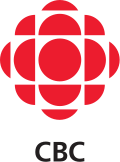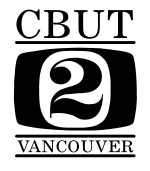CBUT-DT
 | |
| Vancouver, British Columbia Canada | |
|---|---|
| Branding |
CBC Vancouver (general) CBC Vancouver News (newscasts) |
| Slogan | Love CBC |
| Channels |
Digital: 43 (UHF) Virtual: 2.1 (PSIP) |
| Subchannels | 2.1 CBC Television |
| Affiliations | CBC Television |
| Owner | Canadian Broadcasting Corporation |
| First air date | December 16, 1953 |
| Call letters' meaning |
Canadian Broadcasting Corporation VancoUver Television or BUTe St. (the original street CBUT was headquartered at) |
| Sister station(s) |
TV: CBUFT-DT Radio: CBU (AM), CBU-FM, CBUF-FM, CBUX-FM |
| Former callsigns | CBUT (1953–2011) |
| Former channel number(s) |
Analog: 2 (VHF, 1953–2011) Digital: 58 (UHF, 2006–2011) |
| Former affiliations |
Secondary: Radio-Canada (1973–1976) |
| Transmitter power | 103.34 kW |
| Height | 615.4 m |
| Transmitter coordinates | 49°21′13″N 122°57′24″W / 49.35361°N 122.95667°W |
| Licensing authority | CRTC |
| Website |
www |
CBUT-DT, virtual channel 2 (UHF digital channel 43), is a CBC Television owned-and-operated television station located in Vancouver, British Columbia, Canada, which serves as the Pacific Time Zone flagship of the network. The station is owned by the Canadian Broadcasting Corporation, as part of a twinstick with Ici Radio-Canada Télé outlet CBUFT-DT (channel 26), which is operated through corporate subsidiary Société Radio-Canada. The two stations operate from the CBC Regional Broadcast Centre on Hamilton Street in downtown Vancouver, and its transmitter is located atop Mount Seymour. On cable and satellite, the station is available on Delta Cable, Shaw Cable, Telus TV, Bell TV and Shaw Direct.
History

The station first signed on the air on December 16, 1953; as such, CBUT is the oldest television station in Western Canada. The station's original studio facilities were located inside a converted automotive dealership at 1200 West Georgia Street (on the intersection of Bute Street) in downtown Vancouver. However, CBUT was not the first television station to serve Vancouverites; KVOS-TV (channel 12, now a Me-TV affiliate), across the border in Bellingham, Washington, had signed on months earlier as a CBS affiliate. CBUT has broadcast in English for most of its existence, except for a period from 1973 to 1976 when French language programmes from Télévision de Radio-Canada aired on weekend mornings;[1] this secondary affiliation ended when CBUFT (channel 26) signed on in September 1976. CBUT was known mainly as "Channel 2" from its inception until 1976.

During the station's early years until 1976, CBUT's station IDs consisted of slides of local Vancouver landmarks with the CBUT logo (the number "2" in Clarendon Bold typeface, contained within a stylized television screen) overlaid, accompanied by the announcement "This is CBUT, Channel 2 in Vancouver;" the ID slide used at the end of local programmes on CBUT featured a larger version of the station's logo on a navy blue background, accompanied by the announcement "This is CBC Television, Vancouver". Beginning with the introduction of CBC's "gem" logo in December 1974, CBUT (unlike other CBC O&Os, which continued using station IDs at the end of their local programmes) began using the "gem" network ID at the end of all programming, network-distributed and locally produced.
In 1975, the CBC consolidated its Vancouver radio and television operations into one building. Prior to this, CBC's Vancouver radio properties – CBU (690 AM), CBU-FM (105.7) and CBUF-FM (97.7) – had operated from a separate studio facility at 701 Hornby Street, within the basement of the Hotel Vancouver. Together, those stations formed the basis of the Regional Broadcast Centre at 700 Hamilton Street, a few blocks east of its previous radio and television facilities.

The station's IDs were changed in 1976 when CBUT changed its on-air branding to "CBC British Columbia," with the initial IDs featuring a totem pole superimposed over local landmarks, after which the totem pole zoomed out and turned into the letter "T" in the station brand.
In recent years, CBUT, as with all CBC-owned stations, has de-emphasized local programming in favour of network programming distributed out of Toronto. As of 2002, the station only aired sporadic local non-news programming and dropped all use of local station identifications in favour of using only network IDs; in addition, due to budget cuts, the CBC integrated CBUT's master control operations (as it did for all of its other owned-and-operated stations) into the master control facility at the Canadian Broadcasting Centre in downtown Toronto. Recently, however, CBUT has increased its local programming with the introduction of a locally themed lifestyle programme, Living Vancouver (which has since been cancelled), as well as the addition of several new local newscasts.[2]
Transmitters
CBUT's over 85 analogue rebroadcast transmitters were located on the Lower Mainland, Vancouver Island, the Okanagan, and areas not previously occupied by a private CBC affiliate.
Due to federal funding reductions to the CBC, in April 2012, the CBC responded with substantial budget cuts, which included shutting down CBC's and Radio-Canada's remaining analogue transmitters on July 31, 2012.[3] None of CBC or Radio-Canada's television rebroadcasters were converted to digital; CHAN-DT is the last major network station in Vancouver to operate rebroadcasters throughout the province.
Programming
CBUT currently produces a number of programs for CBC Television. Portions of Marketplace are produced at CBUT, as were portions of the programme Hemispheres, the now-cancelled national version of Canada Now and the late-night independent film programme ZeD.
Locally produced programs formerly aired on CBUT
Some of these programs were also seen on the CBC network, either regionally or nationally.
- Canada Now (national supper-hour newscast)
- Cariboo Country (drama)
- Celebrity Cooks (cooking)
- Good Rockin' Tonite (music videos)
- Living Vancouver (lifestyles)
- Northwood (teen drama)
- Reach for the Top (quiz show)
- Rich Little's Christmas Carol (holiday special)
- Switchback (teen variety)
- The Beachcombers (drama)
- The Urban Peasant (cooking)
- The Wolfman Jack Show (musical variety)
- ZeD (independent short films)
Digital television
Digital channel
| Channel | Video | Aspect | PSIP Short Name | Programming[4] |
|---|---|---|---|---|
| 2.1 | 720p | 16:9 | CBUT-DT | Main CBUT-DT programming / CBC British Columbia |
Analogue-to-digital conversion
CBUT shut down its analogue signal, over VHF channel 2, on August 31, 2011, the official date in which Canadian television stations in CRTC-designated mandatory markets transitioned from analogue to digital broadcasts. The station's digital signal was relocated from its pre-transition UHF channel 58, which was among the high band UHF channels (52-69) that were removed from broadcasting use as a result of the transition, to post-transition channel 43.[5] Through the use of PSIP, digital television receivers display CBUT-DT's virtual channel as its analogue-era VHF channel 2.
Post-transition, CBUT's downconverted the high definition video resolution for its digital signal from 1080i to 720p.[6]
News operation
CBUT-DT presently broadcasts 8.5 hours of locally produced newscasts each week (with 90 minutes on weekdays and 30 minutes each on Saturdays and Sundays); in regards to the number of hours devoted to news programming, it is the highest local newscast output among CBC Television's stations (either owned-and-operated or affiliated), although it now has the lowest newscast output among the Vancouver-Victoria market's television stations – its weekly news total is far behind CTV O&O CIVT-DT (channel 32) (which airs 38 hours of newscasts each week) and Global O&O CHAN-DT (channel 8) (which broadcasts 46 hours each week).
In years past, the supper hour newscast (which was a completely locally produced gram until the introduction of the national Canada Now) was known as Hourglass, Newscentre, CBC Evening News, Broadcast One and CBC News: Vancouver. On February 19, 2007, CBUT restored an hour-long local newscast to its schedule with the debut of a local edition of CBC News at Six (which was later retitled CBC News: Vancouver in July of that year), which retained the Canada Now name and was originally anchored by former national Canada Now anchors Ian Hanomansing and Gloria Macarenko. In September 2009, the early evening newscast expanded to 90 minutes, with the addition of an hour-long block at 5:00 p.m. and the removal of the 6:30 p.m. half-hour of the programme.
In April 2010, CBC Television entered into a news share agreement with CHEK, in which both stations share news story content and resources. Tony Parsons also joined the CBC to anchor both CBUT's early evening news block and CHEK's 10:00 p.m. newscast, remaining with both stations until his retirement in 2013. In addition, CHEK formerly carried a simulcast of CBC News: Vancouver at 6 and Vancouver at 11 while CBUT also produced a weekend 6:00 p.m. newscast for that station.[7] As of April 10, 2016, CHEK no longer carries CBUT's newscasts; on October 5, 2015, CHEK replaced the 6:00 p.m. airing of CBC News: Vancouver (since renamed as CBC Vancouver News) with its own half-hour 6:00 p.m. newscast, hosted by former CTV and Global TV reporter Ben O’Hara-Byrne,[8] while on April 10, 2016, CHEK dropped the 11:00 p.m. airing of CBC Vancouver News in favor of an encore presentation of the 10:00 p.m. CHEK newscast on weeknights and various programming on Sundays.
As of June 2013, weather segments seen on CBUT's newscasts are broadcast in HD, while video from other studio and field cameras are transmitted in standard definition and are upconverted to a 16:9 widescreen format in the control room.
On July 30, 2014, CBUT has announced that Andrew Chang will begin anchoring the early evening newscasts starting September 1, succeeding Gloria Macarenko, who announced on her last day of her newscasts that Macarenko will become host of CBC Radio's The Story from Here. However, Macarenko will remain host of Our Vancouver while producing interview segments during CBUT's evening newscasts.[9]
Notable current on-air staff
- Gloria Macarenko - host of BC Almanac on CBC Radio One; Our Vancouver host; also special assignment reporter
Notable former on-air staff
- Adrienne Arsenault - reporter (1993–1998; now with CBC News' The National)
- Gillian Findlay - reporter (1982–1985; now at the fifth estate)
- Dawna Friesen - reporter (now anchor of Global National)[10]
- Bill Good - anchor (now retired from CTV Vancouver and CKNW 980)
- Ian Hanomansing - anchor/reporter (1988–2010; reporter for CBC News' The National; now host of CBC News Now)
- Anton Koschany - reporter (1977–1979; now executive producer of CTV's W5)
- Claire Martin - meteorologist
- Tony Parsons - 5:00, 5:30 and 6:00 p.m. anchor (2010–2013; now retired)
- Jack Webster - reporter, Hourglass (deceased)
Out-of-market cable coverage
In addition to its coverage in British Columbia, CBUT has a significant American audience in Washington State. The station's signal is receivable over-the-air in the city of Bellingham. It is also available on cable to nearly one million Comcast subscribers in the Puget Sound region; Comcast's Puget Sound system also began offering CBUT's digital signal in high definition in July 2009.[11] CBUT is also available in both standard and high definition in Central Washington on Wave Broadband's Lake Chelan area system.[12]
References
- ↑ Vancouver Broadcasters station history (1976)
- ↑
- ↑ Speaking notes for Hubert T. Lacroix regarding measures announced in the context of the Deficit Reduction Action Plan
- ↑ RabbitEars TV Query for CBUT
- ↑ Digital Television - Office of Consumer Affairs (OCA)
- ↑ Canadian TV, Computing and Home Theatre Forums - View Single Post - CBC HD Switches To 720p From 1080i
- ↑ Tony Parsons joins CBC News Vancouver
- ↑ CHEK 6 p.m. newscast – October 5, 2015
- ↑ Andrew Chang joins CBC Vancouver as TV news anchor
- ↑ Infantry, Ashante (July 13, 2010). "Dawna Friesen named Global news anchor". Toronto Star.
- ↑ Comcast's list of 33 new HD channels includes MSNBC, MTV
- ↑ http://www.broadstripe.com/files/lineup/Chelan.pdf
External links
- Official website
- Canadian Communications Foundation - CBUT-DT History
- Query the REC's Canadian station database for CBUT-DT
- Query TV Fool's coverage map for CBUT-DT